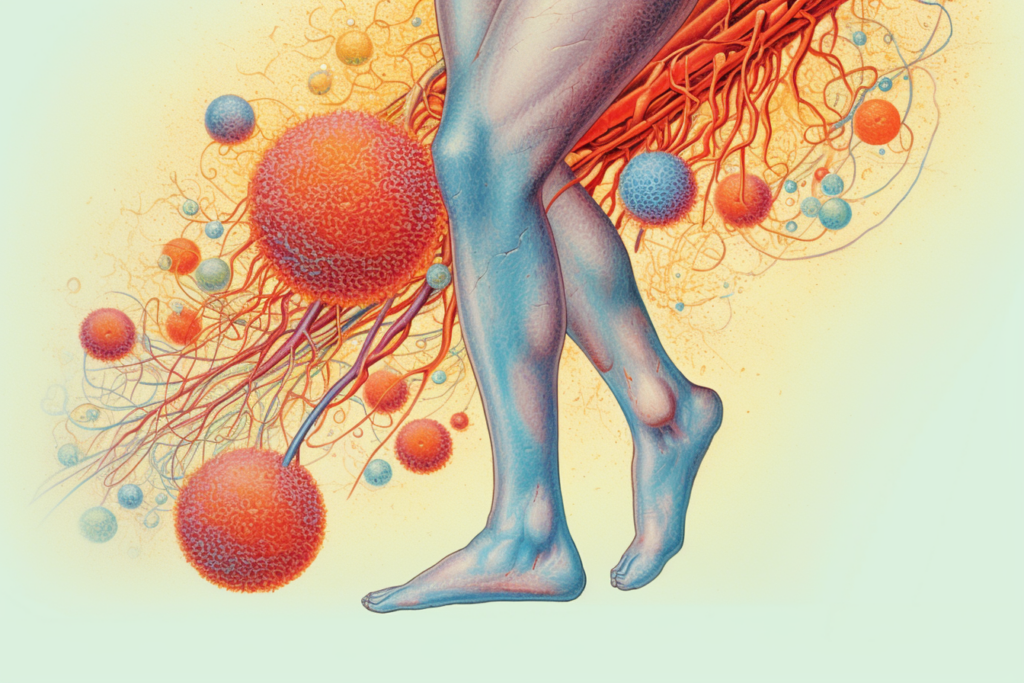Welcome to our exploration of the fascinating world of skin regeneration! Imagine your skin as a bustling city, with each cell playing a unique role in keeping the city functioning smoothly. In this city, there are some special citizens known as stem cells, and they are the superheroes of skin regeneration. They have the incredible ability to transform into different types of cells, much like an actor taking on different roles in a play.
Among these stem cells, we find the epidermal stem cells, which are like the city’s construction workers. They are responsible for building and maintaining the skin’s outer layer, the epidermis. These cells are a subset of the larger group of skin stem cells, which include other types such as the hair follicle stem cells and mesenchymal stem cells.
Hair follicle stem cells, for instance, are like the city’s gardeners, taking care of the hair follicles, which are akin to the city’s gardens. They ensure that the hair grows properly and contributes to the overall beauty of our skin city.
Then we have the mesenchymal stem cells, the city’s utility workers, who can turn into a variety of cell types to perform different functions, much like a utility worker who can fix a variety of issues in the city.
In the event of a skin wound, akin to a disaster in our city, these stem cells spring into action for wound repair. They work tirelessly, like emergency responders, to restore the city to its former glory. This process is a testament to the remarkable resilience and regenerative power of our skin.
In this journey, we’ll delve deeper into the roles of these stem cells, particularly the epidermal stem cells, in skin regeneration. We’ll also explore the various cell populations, including the progenitor cells and basal cells, that contribute to this process.
So, buckle up and get ready for an exciting journey into the microscopic city of our skin!
The Skin Epithelium
Now, let’s turn our attention to the skin epithelium, the city’s outer wall. This wall, much like the walls of a medieval city, serves as the first line of defense against external threats. It’s composed of various types of cells, including the epidermal cells and the basal cells.
The epidermal cells are like the city’s guards, standing at the forefront, protecting the city from invaders such as bacteria and harmful substances. They also play a crucial role in maintaining the city’s appearance, much like how city guards contribute to the city’s image of safety and order.
Nestled among the epidermal cells are the basal cells. These cells are like the city’s builders, constantly working to repair and rebuild the city wall. They are a vital part of the cell population that ensures the city wall remains strong and intact.
Within this wall, we also find the epithelial stem cells, the city’s architects. They are responsible for designing and planning the construction and repair of the city wall. They guide the basal cells and other builders in their work, ensuring that the wall is not only strong but also aesthetically pleasing.
In the event of a skin wound, these cells work together to repair the damage. It’s like a city coming together to rebuild after a disaster. The epithelial stem cells design the repair plan, the basal cells carry out the construction, and the epidermal cells guard the city while the repair is underway.
Epithelial Stem Cells
As we continue our journey through the city of our skin, we’re going to meet the city’s architects – the epithelial stem cells. These cells are like the masterminds behind the city’s design and maintenance. They’re the ones who plan and oversee the construction, repair, and renovation of the city.
Epithelial stem cells are a unique group of cells. They’re like the city’s multi-talented architects who can design various types of buildings. In the same way, these stem cells have the ability to differentiate into various types of skin cells. This ability is what makes them so crucial for skin regeneration.
Among the epithelial stem cells, we find the hair follicle stem cells. These cells are like the architects specialized in designing the city’s gardens – the hair follicles. They ensure that the hair follicles are well-designed and functional, contributing to the overall beauty of our skin city.
These hair follicle stem cells reside in a special area known as the stem cell niche, much like how architects have their own offices. This niche provides them with the necessary environment to function effectively. It’s like an architect’s office equipped with all the necessary tools and resources.
In the event of a skin wound, these epithelial stem cells spring into action. They design the repair plan and guide the other cells in the wound repair process. It’s like the city’s architects and builders coming together to rebuild the city after a disaster.
Role of Epithelial Stem Cells in Skin Regeneration
Today, we’re focusing on the role of our city’s architects, the epithelial stem cells, in the process of skin regeneration.
When a skin wound occurs, it’s like a disaster striking our city. Buildings are damaged, the city wall is breached, and the city’s beauty is marred. But fear not, because our city’s architects, the epithelial stem cells, are ready to spring into action.
These cells, especially the hair follicle stem cells, start the healing process by creating a blueprint for repair. They’re like architects drawing up plans to rebuild the city after a disaster. They determine where new buildings should be constructed, where repairs are needed, and how to restore the city’s beauty.
Next, these stem cells begin to divide and differentiate into various types of cells needed for wound repair. It’s like the architects turning into builders, bricklayers, and painters to rebuild the city. They create new epidermal cells to repair the city wall, new hair follicle cells to restore the city’s gardens, and other types of cells as needed.
During this process, the stem cells also communicate with other cells in the skin, such as the dermal papilla cells and the epidermal keratinocytes. It’s like the architects coordinating with the city’s utility workers and gardeners to ensure that the repair work is carried out smoothly and efficiently.
Finally, once the wound is healed, the stem cells return to their normal state, ready to spring into action again when needed. It’s like the architects returning to their offices after the city has been rebuilt, ready to design and plan for the city’s future growth.
Skin Regeneration Treatments
Now, we’re going to explore the world of skin regeneration treatments and the role of our city’s architects, the epithelial stem cells, in these treatments.

In the world of skin regeneration, there are various treatments available, much like how a city has different methods to repair and renovate its infrastructure. These treatments range from topical creams and ointments to more advanced techniques like stem cell therapy.
Topical treatments are like the city’s maintenance crew, taking care of minor repairs and upkeep. They help to maintain the health and appearance of the skin, but they may not be sufficient for more significant damage.
For more severe skin damage, we turn to our city’s architects, the epithelial stem cells. Treatments involving these cells are like major city renovation projects. They aim to rebuild and regenerate the skin at a cellular level.
One such treatment involves the use of hair follicle stem cells. These cells are harvested, cultivated, and then reintroduced into the skin to promote regeneration. It’s like relocating gardeners from one part of the city to another to help restore the city’s gardens.
Another treatment involves the use of mesenchymal stem cells. These cells are like the city’s utility workers, capable of turning into a variety of cell types to perform different functions. They can be used to repair various types of skin damage, from wounds to burns.
The potential for future treatments involving epithelial stem cells is vast. Researchers are exploring new ways to harness the power of these cells to promote skin regeneration. It’s like our city’s architects constantly coming up with new and innovative designs to make our city even more beautiful and resilient.
FAQ
Q: What are epithelial stem cells?
A: Epithelial stem cells are a population of cells in the skin, including the epidermal stem cell and hair follicle stem cell, that play an important role in skin regeneration and homeostasis.
Q: What is the role of epithelial stem cells in skin regeneration?
A: Epithelial stem cells help to maintain and repair the skin by contributing to wound healing and tissue regeneration. They are responsible for the successful completion of epidermal regeneration after skin injury or damage.
Q: What is the difference between epidermal stem cells and hair follicle stem cells?
A: Epidermal stem cells are found in the basal layer of the epidermis and contribute to the regeneration of the epidermis, while hair follicle stem cells are found in the bulge area of the hair follicle and are involved in hair regeneration.
Q: How do stem cells self-renew?
A: Stem cells self-renew through a process called autocrine Wnt signaling, which allows them to divide and differentiate to produce new progenitor cells.
Q: What is the plasticity of epidermal stem cells?
A: Epidermal stem cells have the ability to differentiate into different cell lineages, depending on the environment and biochemical signals they receive.
Q: How do stem cells contribute to wound healing?
A: Stem cells in wound healing help to build new tissue and restore function by differentiating into the specific cell types needed for tissue repair and regeneration.
Q: What is the expression of epidermal stem cells?
A: Epidermal stem cells express a variety of biochemical markers, including preferentially expressed by skin stem cells (PES), which are used to identify and isolate stem cell populations.
Q: What are label-retaining cells?
A: Label-retaining cells are a type of stem and progenitor cell that can be identified and visualized based on their ability to retain a label (such as BrdU) used to mark dividing cells.
Q: Can adipose-derived stem cells be used for skin regeneration?
A: Adipose-derived stem cells (ADSCs) are a potential source of cells for skin regeneration, as they have been shown to differentiate into epithelial and mesenchymal lineages.
Q: How are pluripotent stem cells different from epithelial stem cells?
A: Pluripotent stem cells have the ability to differentiate into any cell type in the body, while epithelial stem cells are committed to the epithelial cell fate and can differentiate into a limited number of cell lineages.
Conclusion
As we conclude our journey through the city of our skin, we hope you’ve gained a deeper understanding of the vital role of epithelial stem cells in skin regeneration. These cells, our city’s architects, are the masterminds behind the design, maintenance, and repair of our skin city.
From the epidermal stem cells that maintain the city wall, to the hair follicle stem cells that care for the city’s gardens, each type of stem cell plays a unique role in keeping our skin healthy and beautiful. They spring into action in the event of a skin wound, working tirelessly to repair the damage and restore the city to its former glory.
In the world of skin regeneration treatments, these stem cells are the stars. They are at the heart of advanced treatments that aim to regenerate the skin at a cellular level. The potential for future treatments involving these cells is vast, with researchers constantly exploring new ways to harness their power.
As we look to the future, we can expect to see even more innovative treatments that leverage the power of these amazing cells. From wound healing to anti-aging treatments, the possibilities are endless. It’s like our city’s architects constantly coming up with new and innovative designs to make our city even more beautiful and resilient.
Thank you for joining us on this journey through the city of our skin. We hope you’ve enjoyed the tour and learned something new about the fascinating world of skin regeneration!



